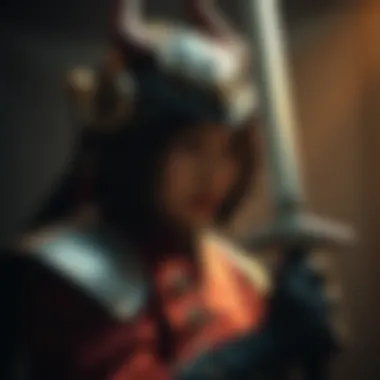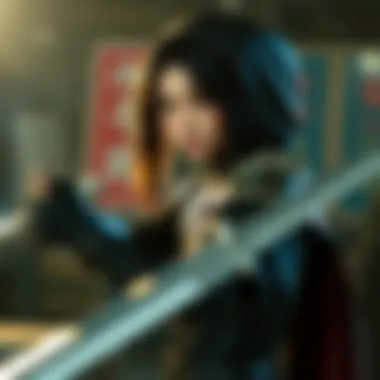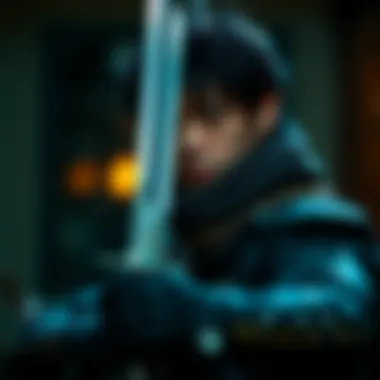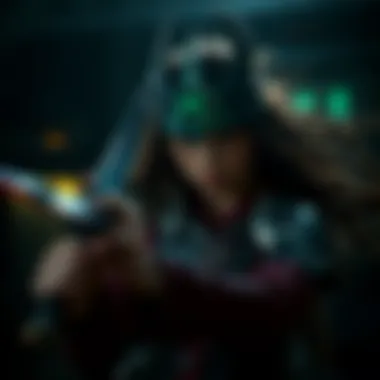Exploring the Art of Demon Slayer Uniform Cosplay


Intro
In the vibrant world of anime fandom, cosplay stands as a dynamic form of expression, allowing fans to embody their beloved characters. Among the plethora of anime inspirations, Demon Slayer: Kimetsu no Yaiba has carved out a substantial niche within this culture, captivating audiences with its intricate narratives and visually stunning art. This article dives into the fascinating realm of Demon Slayer uniform cosplay, shedding light on its significance, the craftsmanship involved, and the community that flourishes around it.
Cosplay isn’t merely a hobby; it's a way for enthusiasts to engage with their favorite series and its characters on a deeper level. For many, wearing the distinctive uniform of a Demon Slayer becomes a bridge to their fantasies—an opportunity to step into shoes not normally walked in during daily life. The costumes, rich in detail and resonance with the anime's lore, reflect the hard work and dedication of the creators behind them.
Through this exploration, we will delve into the elements that define these unique outfits, looking at how they evolved over time and how trends shift with each passing season. We will also touch on how social media plays a pivotal role in shaping cosplay culture, as fans connect, share, and inspire one another across platforms. So buckle up, as we embark on this journey through fabric, paint, and passion—one which showcases how Demon Slayer cosplay not only celebrates the characters but also fosters a vibrant community of fans.
Preface to Cosplay and Its Cultural Significance
Cosplay, a melding of the words "costume" and "play," has blossomed into a vital form of expression within the anime and broader pop culture communities. This section sheds light on its significance, encompassing its role as a creative outlet and a platform for social interaction. In today’s society, cosplay does not merely allow fans to emulate their favorite characters; it's a community-driven phenomenon that nurtures creativity, collaboration, and celebrates individuality in an ever-diversifying cultural landscape.
Definition of Cosplay
At its core, cosplay is the act of dressing up as a specific character from anime, video games, movies, or comics. Typically, this is done with a dedication to accuracy, capturing the essence of the character through thoughtful costume design and sometimes even incorporating mannerisms or dialogue. Other times, it may involve a unique twist, where a cosplayer adds their personal flair to a character, allowing for a playful form of interpretation. It's an art form that welcomes both skilled craftsmen and enthusiasts alike, providing an entry point into a world filled with creativity and fandom.
Origins of Cosplay in Anime Culture
Cosplay origins can be traced back to the advent of science fiction conventions in the 1930s, where fans would dress as their favorite characters. However, it is the rise of anime culture in the 1990s that significantly solidified cosplay's position as a dominant force within fandoms. In Japan, cosplay blossomed as fans began to physically bring animated characters to life at events, becoming a way to embrace and share enthusiasm in a visually creative manner. The narrative twists and emotional depth of anime characters often resonate deeply with fans, igniting a passion that transforms into cosplay. From these conventions, the practice spread internationally, galvanizing a global community that thrives on creativity and shared interests.
Demon Slayer and Its Impact on Cosplay
One cannot discuss modern cosplay without acknowledging the meteoric rise of Demon Slayer: Kimetsu no Yaiba. Launched in 2019, this anime has completely captivated audiences with its stunning visuals, complex characterization, and compelling story arcs. The unique aesthetics of the Demon Slayer uniforms, crafted with meticulous attention to detail, lend themselves beautifully to cosplay practices. Characters like Tanjiro Kamado and Nezuko Kamado have become icons, inspiring fans to replicate their looks down to the last detail. The cultural impact of Demon Slayer stretches beyond mere aesthetics; it also promotes themes of resilience, kinship, and sacrifice, elements that resonate on a personal level with cosplayers. As a result, not only are these costumes sought after but they also become vessels for storytelling and personal connection in the cosplay community.
Cosplay, therefore, transcends the boundaries of performance art; it becomes a collaborative tapestry, woven from the diverse experiences and emotions of its participants.
The Anatomy of a Demon Slayer Uniform
Understanding the anatomy of a Demon Slayer uniform goes beyond visual appeal; it's about dissecting the elements that make these outfits significant in the cosplay community. Each component carries meaning and represents dedication to character, narrative, and artistry. A comprehensive examination helps cosplayers recreate these uniforms authentically while enhancing their own interpretation.
Character Design and User Interpretation
The character design in Demon Slayer is brilliantly unique, with each character's outfit symbolizing their personality, traits, and their roles in the story. Take Tanjiro Kamado, for instance; his green and black checkered haori speaks volumes about his background and fights, balancing tradition with modernity.
When cosplayers create their interpretations, they often infuse personal touches into the character design. This can manifest in variations such as fabric choices or adapted accessories distinct from the original depiction. Emphasizing how a character's design can be interpreted personally encourages cosplayers to think critically about their choices.
Key Elements of the Uniform
The key elements of a Demon Slayer uniform consist of features that capture attention and create a cohesive look. Here we break it down:
Color Scheme
The color scheme in Demon Slayer uniforms often reflects the character's essence and the setting's emotional undertones. Bright colors can denote a lively character, while darker hues might indicate complexity or depth. For example, Nezuko's iconic pink and black palette encapsulates her fiery spirit and connection to nature. The distinct choice of colors not only enhances the visual impact but also strengthens the thematic representation in the cosplay community.
This flexibility in choosing colors allows for creative engagement while staying true to the character's identity. However, it poses a challenge; striking the right balance between personal expression and faithful representation can be tricky.
Design Patterns
Patterns are another vital aspect of the uniform, serving to establish identity and kinship. The lattice pattern seen in some outfits, such as Kanao Tsuyuri's, signifies underlying familial connections and traditions that resonate throughout the story.
Crafting these intricate patterns can be a rewarding aspect of cosplay, requiring skills in fabric manipulation. However, they also demand attention to detail, as poorly executed patterns can detract from the overall impact. Thus, investing time into mastering the design can pay dividends in the finished product.
Accessories
Accessories can often be the silent yet striking elements that complete a uniform. Items like Tanjiro’s hanafuda earrings or the unique sword shapes hold substantial narrative weight. These accessories aren’t just adornments; they convey rich backstories and play crucial roles in character branding.
Integrating accessories into the cosplay can heighten authenticity while offering opportunities for creative flair. A well-chosen accessory can cater to both practicality and aesthetics, yet it's essential to ensure they fit cohesively with the overall outfit.


Materials and Techniques for Crafting Cosplay
When we dig into the world of Demon Slayer uniform cosplay, we quickly realize that the magic doesn’t just happen in the design. It's about the materials and techniques that breathe life into that fabric. Crafting a cosplay outfit is like mixing paints for a masterpiece; you have to choose the right colors and textures to get it just right. Essentially, the materials chosen can reflect the character's essence, adding authenticity to the portrayal.
Choosing the Right Fabrics
Selecting the right fabric is crucial. If you want your uniform to look like it stepped right from the anime scenes, consider what each fabric can offer. Cotton and polyester blends are excellent choices for their durability and breathability. These materials can withstand wear while still providing comfort during long convention days. Also, think about satin for that sleek finish to reflect the traditional Japanese clothing styles like those worn by Tanjiro and Nezuko.
Here are some commonly used fabrics and their specific benefits:
- Cotton: Soft, breathable, and easy to sew. Good for all-day wear.
- Polyester: Durable and often less expensive. It holds color well.
- Satin: Eye-catching and smooth, perfect for show-stopping outfits.
- Fleece: Great for warmer costumes, adds comfort and warmth.
Every fabric is different; therefore, folks must consider the character’s role in Demon Slayer and tailor the fabric choice accordingly. For instance, many choose heavier materials for the demon-hunting characters to embody their ruggedness. On the other hand, lighter materials may work better for those characters with a more delicate aura, like Nezuko.
Sewing Techniques and Tips
Sewing is where the magic merges with technique. This stage can make or break a cosplay outfit. Each stitch you sew not only brings the fabric together but also reflects your dedication as a cosplayer. Basic sewing techniques can vastly improve the final look of your costume, so it’s worth honing your skills before beginning.
Everybody's got their own tricks up their sleeves, but a few tried-and-true tips often help:
- Practice on Scraps: Before you face your beloved fabric, try out stitches on leftover material. Trust me, it can save you from a world of stress.
- Use Proper Thread: Match your fabric with the right thread, thinner for lighter fabrics and sturdier for heavier ones.
- Iron As You Go: A well-pressed seam makes a world of difference for the final appearance. Not to mention, it can help in aligning pieces properly.
Tip: Always use sharp scissors to cut your fabric. Dull scissors can lead to frayed edges, resulting in a less polished look—definitely not the vibe we want when embodying a Demon Slayer.
Utilizing Heat Transfer and Printing
If you’re aiming for that perfect design, consider heat transfer and printing techniques. These methods allow people to add intricate designs directly onto the fabric, such as the Kanji symbols or patterns found on the uniforms. While some might think this is a complicated endeavor, it can actually be quite straightforward.
For example, you could try:
- Iron-on Transfers: A quick and easy way to add designs. You can find transfer papers for inkjet printers, allowing for personalization like no other.
- Sublimation Printing: This method infuses the dye into the fabric, ideal for bold designs that last longer and withstand multiple washes.
- Direct-to-Garment (DTG) Printing: Provides the ultimate detail for complex patterns, though it may be a bit pricier.
Incorporating these techniques not only enhances the Demon Slayer uniform’s appearance but also ensures longevity in the garment. You want your costume looking sharp year after year, don’t you?
Overall, materials and techniques form the backbone of any inspiring cosplay journey. They set the stage for transformative portrayals of beloved characters while also enabling attendees to express their unique creative flair.
Cosplay Styles and Representations
In examining the art of Demon Slayer uniform cosplay, one must appreciate the diverse tapestry of styles and representations that thrive within the community. These elements not only define how fans interpret their favorite characters but also reflect their individuality and understanding of the medium.
Themes of creativity and freedom of expression often surface in discussions surrounding cosplay. The very act of embodying a character is a journey into an alternate reality, where fans can step into the shoes—or sandals—of Tanjiro or Nezuko. This connection fosters deeper understanding and appreciation for the anime itself, making cosplay not just a hobby but a significant aspect of fandom culture.
Traditional vs. Modern Interpretations
The debate between traditional and modern interpretations in cosplay can be likened to the choice between classical music and contemporary pop. Traditional cosplay, with its strict adherence to original character design, speaks to die-hard fans who cherish accuracy above all. They meticulously replicate every stitch, color, and accessory, channeling the spirit of the character in a way that is almost reverent.
On the flip side, modern interpretations encourage a certain freedom of expression, enabling cosplayers to put their twist on established designs. Such approaches allow for imaginative variations—a Demon Slayer uniform can receive a splash of neon colors or detailed embellishments reflecting the wearer’s style. This blend of tradition and innovation fosters a rich creative exchange among fans, making each cosplay unique yet intimately tied to the original source material.
Gender Expression and Character Interpretations
Gender expression in cosplay is an area filled with nuances, especially within the context of characters from Demon Slayer. The anime's diverse cast offers ample opportunity for cosplayers to explore their identities and challenge norms. For instance, a male cosplayer might don Nezuko’s attire, embracing the fluidity of gender representation that cosplay so beautifully allows.
The motivations behind these character interpretations can be deeply personal. Some may choose to represent characters as they see themselves, while others may want to subvert traditional gender roles or simply infuse their personality into their creations.
“Cosplay is not just about the costume; it’s a vehicle for self-exploration and identity.”
Moreover, the emotional connections created through character portrayal often enhance the bonding experience in the cosplay community. Cosplayers find common ground through shared experiences, forming relationships that go beyond mere fandom. By embodying characters of various genders and interpretations, they cultivate spaces that celebrate diversity and creativity.


As the landscape of cosplay continues to evolve, so too will the styles and representations around Demon Slayer. The fusion of traditional respects with modern interpretations propels the community forward, inviting both newcomers and veterans to participate in a rich, collaborative cultural expression.
The Role of Social Media in Cosplay
Social media plays a pivotal role within the cosplay world, acting as a vibrant marketplace of ideas, creativity, and community engagement. For fans of Demon Slayer, platforms provide a space to share costumes, collaborate on projects, and interact with fellow enthusiasts. Social media has become the lifeblood of cosplay, reflecting the ever-evolving trends and popular figures in this art form while fostering connections that may last a lifetime.
Platforms for Showcasing Work
In today's digital age, a myriad of platforms are available where cosplayers can flaunt their creations. Instagram has emerged as a top contender, allowing users to post stunning images that capture the details and creativity of their costumes. The visual nature of the platform encourages high-quality photography and encourages cosplayers to present their outfits in striking ways. TikTok, on the other hand, has surged in popularity, with creators showcasing their craftsmanship through engaging videos that depict everything from the behind-the-scenes process to final costume reveals.
Some key platforms for showcasing cosplay include:
- Instagram: Ideal for photo-sharing and reaching a broad audience.
- Facebook: Great for joining groups focused on specific fandoms and discussions.
- TikTok: Perfect for quick, dynamic showcases and tutorials.
- Reddit: Hosts communities where cosplayers share their work, seek advice, and discuss trends.
Success on these platforms isn’t just about a pretty picture. It’s equally about the stories behind the costumes and connecting with an audience that resonates with those narratives. Sharing progress shots and even bloopers can humanize the process, inviting followers into the journey of creation.
Community Support and Feedback
The digital landscape fuels a sense of camaraderie that can be hard to find outside of cosplay conventions. The online community thrives on mutual support, where feedback is often constructive yet heartfelt. Members encourage one another through challenges, offering tips on costume construction or fabric choices, which can be incredibly helpful for those just getting started or trying out new techniques.
In many cases, a simple comment or reaction can uplift a cosplayer who’s investing hours into their project. It’s not uncommon for cosplayers to form lasting friendships through these digital interactions, with many attending conventions together or collaborating on cosplays.
Moreover, the accessibility of these platforms has democratized the cosplay culture. No longer confined to a select few, anyone can participate, regardless of skill level or location. This open community fosters an atmosphere of creativity, where everyone’s work is celebrated—be it a beginner’s first costume or an intricate, professional-level piece. The sharing of experiences becomes a vital part of the learning process, turning what could be a solitary pursuit into a shared passion.
"In a world where creativity thrives, social media serves as a bridge, connecting cosplayers across the globe."
As professionals or hobbyists, cosplayers can leverage social media to bolster their visibility. Brands may notice their talent and offer sponsorships or collaborations, further blurring the lines between hobby and career. Thus, it’s clear that social media doesn’t merely serve the purpose of showcasing but drastically reshapes the landscape of cosplay, advancing its evolution and accessibility to countless enthusiasts.
Challenges Within Cosplay Culture
Cosplay culture is a vibrant and multifaceted community, yet it isn't without its obstacles. Understanding these challenges provides insight into the complexities faced by cosplayers, especially those focused on beloved series like Demon Slayer. These challenges range from societal expectations to financial constraints, all of which can shape the experience of creating and wearing a costume.
Navigating Expectations and Criticism
When diving into cosplay, the first challenge that often rears its head is the plethora of expectations that come from both the self and the community. Cosplayers frequently find themselves caught between their artistic vision and the strict standards set by peers or influencers. Criticism can come from various angles—some might have a problem with the accuracy of a costume, while others may criticize the choice of character itself.
Being aware of these factors is crucial. The reality is that not every cosplay will please everyone. A cosplayer might pour time and money into a Demon Slayer uniform, only to face comments on social media about its perceived flaws. This can lead to self-doubt and a reluctance to share one’s work. However, finding a supportive circle can help mitigate these feelings. Many cosplayers engage in healthy discourse through platforms like Reddit or Facebook groups dedicated to anime culture, where they can share experiences and receive constructive feedback.
"In cosplay, your experience is uniquely your own—no one can wear your costume as well as you can."
This sentiment resonates deeply as cosplayers must remind themselves that their enjoyment and personal expression should take precedence over external opinions.
Financial Considerations in Costume Creation
Creating a stunning Demon Slayer cosplay can be a costly endeavor. Fabric, patterns, props, and tools add up quickly, which poses a barrier for many aspiring cosplayers. With the rise in popularity of certain characters, the materials for creating these outfits may also become more expensive. For instance, fabric choices like brocade or silk, which are often favored for their visual appeal, might stretch the budget.
Moreover, the cost of convention attendance and transportation further complicates the financial landscape. As many cosplayers know, investing in a quality costume often means balancing the books against participation in conventions, where one can showcase their hard work. It's a juggling act that can leave a dent in anyone's wallet but also comes with emotional rewards that can sometimes make that cost worthwhile.
In this regard, cosplayers often look for economical alternatives. Upcycling old clothing or sourcing materials from local thrift shops or online marketplaces may not only ease financial strain but also add a unique touch to the costume that is reflective of the creator’s personality. Participation in community events that offer costume competitions with material prizes can also serve as a beneficial avenue.
Ultimately, while financial challenges can make cosplay daunting, they encourage creativity and resourcefulness. Finding creative solutions can turn limitations into unique advantages, allowing cosplayers to make their adaptations distinct while being budget-conscious.
Participation in Conventions and Events
In the vibrant world of cosplay, participation in conventions and events serves as a cornerstone for community engagement and personal expression. These gatherings offer fans of Demon Slayer a platform not only to showcase their craftsmanship but also to connect with like-minded enthusiasts. These events are akin to a celebration, where everyone, from seasoned cosplayers to newcomers, can immerse themselves in a shared passion for anime.
Attending conventions provides several tangible benefits. Firstly, it presents an opportunity for cosplayers to display their hard work and creativity in a setting that appreciates their efforts. Whether one has meticulously tailored their Tanjiro uniform or crafted intricate accessories inspired by Nezuko’s design, there’s a sense of accomplishment that comes with participating in these events. The thrill of entering a costume contest can’t be overstated, as it’s a chance to be recognized among peers for one's skills and commitment.
But it’s not just about competition.


- Community Building:
- Interactive Learning:
- Cultural Exchange:
- Merchandising Opportunities:
- Conventions foster a spirit of camaraderie, allowing cosplayers to meet similar folks who share their love for Demon Slayer. This network can lead to lasting friendships and partnerships for future projects.
- Workshops and panels often share invaluable insights, from sewing techniques to makeup application, helping cosplayers refine their craft.
- Events offer a window into different interpretations of characters, showcasing how various cultures and backgrounds influence cosplay. It’s fascinating to see how a character like Zenitsu can be represented through various lenses.
- Vendors at conventions offer unique merchandise. Whether it's art prints, custom figures, or character-themed accessories, these events are a treasure trove for fans eager to enhance their collections.
Participation in these conventions is not without its considerations, however. It can be costly, with expenses ranging from entry fees to travel and accommodation. Yet, many find that these costs are worth the rich experiences they offer. Through shared experiences, cosplayers strengthen their ties to one another and bolster the Demon Slayer fandom as a whole.
Cosplay Competitions and Showcases
Cosplay competitions are among the highlights of any convention, drawing sizable crowds and a mix of emotions—from nerves to excitement. Entrants showcase not only their costumes but also their performance skills. Some presentations emphasize storytelling, bringing an entire character's essence to the stage, while others focus on the technical aspects of their costumes. Participating in a competition can be a learning curve and an adrenaline rush all rolled into one.
Competitors are often judged on various metrics, including:
- Creativity: Originality in design and presentation.
- Craftsmanship: Quality of materials used and sewing techniques.
- Character Representation: Faithfulness to the original character in both look and mannerisms.
The thrill of performing in front of an audience, complemented by the roar of applause, feels like a rite of passage for many cosplayers.
Networking Opportunities in Fandom Spaces
Convention spaces are a real melting pot of fandom. Opportunities for networking abound, allowing cosplayers to expand their social circles and learn from one another’s experiences. Participants often exchange social media handles, facilitating ongoing communication that extends beyond the event.
Making connections during these events can lead to:
- Collaboration: Working together on future projects can lead to exciting new ideas and creations.
- Mentorship: Novice cosplayers seeking guidance can find skilled veterans willing to share their secrets of the trade.
- Event Coordination: Many convention-goers get involved in organizing future events, contributing to the growth and sustainability of the cosplay community.
Networking in fandom spaces isn't just about sharing contacts; it's about building a support system that thrives on encouragement and creativity.
In summary, participating in conventions and events is essential for anyone serious about Demon Slayer cosplay. It not only empowers individuals but also invigorates the broader community, ensuring that the art of cosplay continues to flourish.
The Future of Demon Slayer Cosplay
As the world of anime continues to evolve, Demon Slayer remains a beacon of popularity and creativity within the cosplay community. This section addresses the importance of recognizing the trajectory of Demon Slayer cosplay, focusing on three pivotal aspects: character popularity trends, innovative costume design techniques, and a growing emphasis on sustainability and eco-friendliness.
Trends in Character Popularity
The landscape of character popularity can shift as readily as the wind. Demon Slayer features a diverse cast, each of whom resonates differently with fans.
- Tanjiro Kamado has become a symbol of perseverance, endearing himself to many through his unwavering determination. His character arc, from a humble demon slayer to a skilled fighter, has garnered admiration.
- Nezuko Kamado, with her unique heritage and compelling backstory, is also climbing the ranks. Her dual identity as both a human and a demon brings a complex layer to her character that fans admire.
- Meanwhile, Zenitsu Agatsuma, known for his comedic relief and unexpected bravery, charms many with his relatability.
Keeping track of these evolving interests helps cosplayers design costumes that engage audiences. Trends can emerge and vanish, akin to leaves in autumn. Cosplayers often gather feedback through social media and conventions to refine their choices to suit what fans crave.
Innovative Techniques in Costume Design
Cosplay is as much about craftsmanship as it is about representation. The Demon Slayer uniforms demand meticulous attention to detail to capture each character’s essence effectively. Modern techniques have emerged that enhance the craftsmanship involved:
- 3D Printing: This tech has been a game changer, allowing cosplayers to create intricate masks, weaponry, and accessories with precision that was hard to achieve with traditional methods.
- Digital Fabric Printing: This method allows for customization that reflects specific character designs, particularly the unique patterns seen on Demon Slayer uniforms. It offers a vibrant finish that stands out in competitions and photoshoots.
- LED and Light Effects: Incorporating lights into costumes is on the rise. Characters like Tanjiro and Zenitsu have special techniques that can be enhanced visually with creative lighting elements, adding depth to performances.
These innovations continue bringing fresh energy to cosplay, keeping the community motivated and engaged.
Sustainability and Eco-Friendly Practices
As environmental concerns gain prominence globally, the cosplay community starts adapting as well. The future of Demon Slayer cosplay is leaning towards more sustainable practices—a necessary and commendable direction.
- Repurposing Materials: Cosplayers who previously relied heavily on synthetic fabrics are now gravitating towards upcycled materials. This approach not only reduces waste but also fosters a unique aesthetic, as each costume reflects a personal touch.
- Local Sourcing: Many cosplayers aim to use locally made fabrics and tools, reducing carbon footprints associated with shipping. Supporting local artisans keeps the community strong and encourages homegrown creativity.
- DIY Approaches: More enthusiasts craft their cosplay outfits, reflecting a personal style rather than merely mimicking commercial designs. This self-sufficiency can dramatically reduce reliance on mass-produced, less sustainable options.
"The future isn't just about making unique costumes; it's about making them responsibly for the planet we cherish."
This shift to sustainability not only aligns with broader global initiatives but also resonates with fans who are increasingly conscious of their environmental impact.



